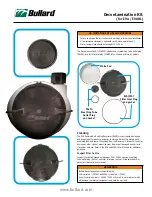
www.bullard.com
8
/Lo
w Battery Alarm/Do
ffing the Blo
w
er / T
roubleshooting
Low Battery Alarm and Low Flow Alarm
The EVA1 Blower unit is equipped with a Low Battery Alarm and a
Low Flow Alarm.
The Low Battery Alarm will sound an intermittent 77 dba electronic beep
indicating that there are approximately 15 minutes of remaining battery capacity.
The delays between beeps will get shorter and shorter as time runs out.
The Low Flow Alarm will sound a continuous 77 dba electronic beep indicating that
the flow to the hood has dropped below the design specification of 185 lpm = 6.5
CFM (Note: The NIOSH minimum required flow is 170 lpm = 6 CFM).
When either of these alarms sounds, the user should immediately do
the following:
Leave the hazard area
Remove the headpiece
Disconnect the breathing tube from the hood
Check the airflow with the airflow indicator (see page 4).
Check the operation of the low-flow alarm by blocking the end of the breathing
tube. The device will first ramp up to compensate and if correct flow cannot be
achieved, the alarm will sound within 5 seconds.
If the airflow indicator indicates insufficient airflow, the battery should be fully
charged (see “Battery Pack” on page 2), and/or the filter/cartridge should be
replaced.
NOTE
The EVA1 blower is provided with a circuit to protect the battery. It will
not allow the battery to be discharged below a safe voltage for the cells,
regardless of airflow, without the Alarm sounding. When the battery
reaches the voltage cutoff it will automatically cease operation. When the
Low Battery Alarm sounds and the filter cartridges are not clogged, the
battery should be recharged to protect the battery and thereby prolong
the working life of the unit. If the ball in the Airflow Indicator is BELOW
or PARTLY BELOW the PASS LINE with a fully charged battery, the filter
cartridges may need to be changed.
Doffing the Respirator
Prepare to doff the blower, battery and hood in a safe, hazard-free area and
do the following (in conjunction with your employer’s standard operating
procedures):
• Remove the hood.
• Turn the blower off by holding down the on/off switch for 5 seconds. This is
confirmed by a long beep and a shut down of the motor.
• Remove the waist belt.
• Disconnect the hood from the breathing tube.
• Disconnect the breathing tube from the blower.
• Clean and inspect components as necessary.
• Place battery on charger (as desired).
• Place components in storage.
Troubleshooting
The following guide will assist you in troubleshooting to locate possible issues with your respirator:
Circumstance
Possible Cause(s)
Solution
Low Battery Alarm is sounding
Low Voltage
Charge the battery
Blower malfunction
Return blower for anyalysis
Low Flow Alarm is sounding
Clogged/damaged air-purifying filter element
Replace the filter/cartridge
Battery Low
Re-charge the battery
Blower malfunction
Leave hazardous area immediately and check
equipment. If the problem persists and no damage
is found, return equipment for repair.
Replace breathing tube and/or hood.
Hood neck cuff is restricting flow
Adjust neck cuff position
Smell or taste contaminant
Equipment damaged
Leave hazardous area immediately and check
equipment
Filter needs to be replaced
Replace filter
Low airflow
Leave hazardous area immediately and check
equipment
If the problem persists and no damage is found,
return equipment for repair
Blower unit does not run full service life
Damaged Battery
Return battery for analysis
Malfunctioning Battery Charger
Return charger for analysis
Hood neck cuff is restricting flow
Adjust neck cuff position
The use of any filter/cartridge not approved with the EVA1 blower unit may put
the user at risk and could result in death or serious injury.
WARNING


























